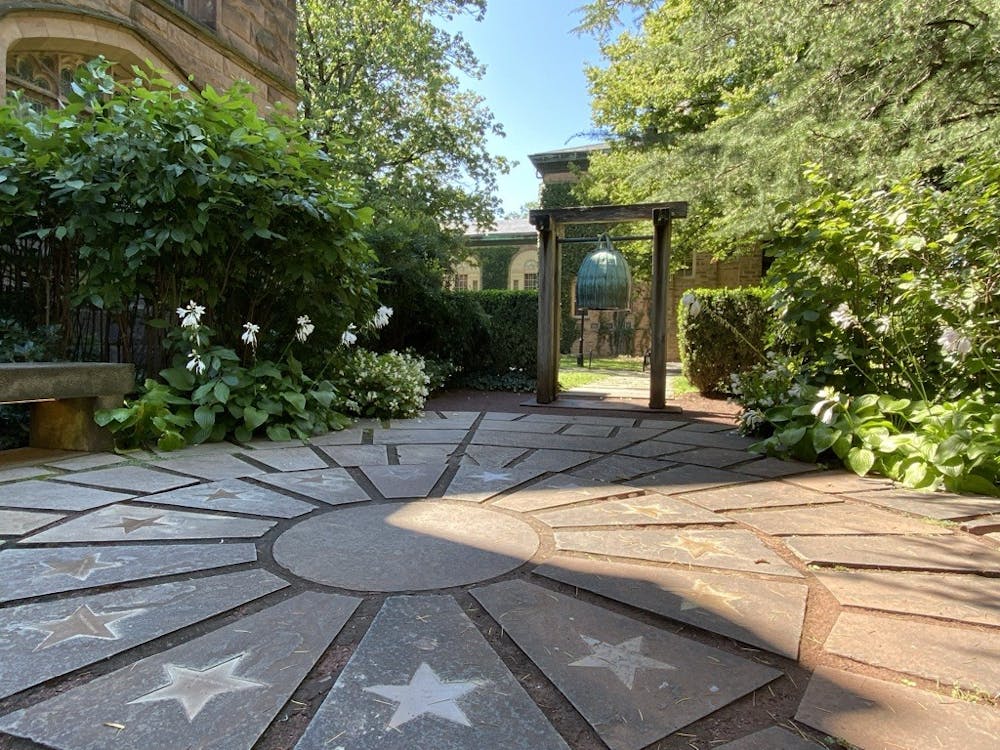A walk across the Princeton campus with attentive-enough eyes reveals it as a collection of monuments and memorials. Every stone laid, every piece of wood fitted, and every last bit that makes up this campus seems to carry with it a name or story of some sort. As students, we live and learn among arches, towers, and halls spotted with engravings, plaques, and other markers that both embody and perpetuate the history of this nation and university.
The history embodied by this campus reaches as far back as its colonial years, yet also already holds the events of the past year. From Cannon Green, I have seen in recent days both statues of those who signed the nation’s founding documents and signs for a silent vigil honoring members of the community lost to COVID-19. It all leaves the campus as a rich place to contemplate our history and our memory, as well as the lives of those who once walked this same campus.
On the second day of classes this semester, I took such a walk, stopping by the University’s 9/11 Memorial, which is nestled between East Pyne Hall and Chancellor Green. Facing Nassau Hall, yet partially shrouded in beautiful plants and delicate white flowers, the memorial is not one that often catches my attention as I walk across campus. With some free time before my next class, however, I paused for a moment to walk past the bell marking the memorial’s entrance and take it in.
Under the bright summer sun, some of the 14 stars carrying the names of Princeton alumni who died on 9/11 gleamed a deep golden hue, while others stayed in the shadows. All, however, formed a circle on the ground, around which I slowly walked as I read each name and class year. As I did this, I thought the same thing my mind inevitably goes to when thinking about 9/11: How can I ever forget if I never remembered?
Unlike the statues of former president John Witherspoon and James Madison Class of 1771 on East Pyne, these 14 stars honor 14 people whose closest friends and family are, more than likely, mostly still alive. For them, I imagine visiting this memorial is more like visiting a gravesite. But for me, someone born only 18 months before the attacks, these 14 stars feel almost as historically and emotionally distant in my memory as the aforementioned statues. Yes, I may have already been alive that September morning, but my earliest memories aren’t from until a couple years after the towers fell.
In all honesty, this distance I feel from 9/11 has kept me from ever fully, viscerally understanding what that day was like. I have no story of where I was when I first heard or saw the news. I have no story of how my life changed that day. Instead, I’ve spent close to 20 years remembering in a way totally foreign to most American adults: by imagining what that day and life before it was like. By coming of age with no sense of a pre- and post-9/11 world — just the world as it is.
In fact, the yearly commemorations come and go with so much attention — and even political tension — in a way that will never fully make sense to me. Of course, I feel a sense of deep sadness, and even confusion, at people committing such heinous acts. Still, I never seem to reach the place older adults do, where they feel an intense gut reaction of shock, terror, grief — or sometimes even hatred — that can build up around such a defining moment as 9/11. But 9/11 wasn’t a defining moment like that for me, and I’d be willing to say that’s true for the many other Princeton undergraduates also too young to remember or even have been alive at the time.
All these thoughts floated around in my mind as I walked around those 14 stars, reading names and class years yet again. They’re thoughts I revisit every time 9/11 comes up. And then they always lead me to the one 9/11 story I do have and will never forget.

I was 17 years old when I first visited Ground Zero. Touring the museum, I eventually entered the hall with pictures and names of all who died. Immediately to my right as I entered was a very young girl held in the right arm of a man I assumed to be her dad. With his other arm, the man was pointing out one of the pictures on the wall, whispering something to the little girl. Then, she reached out with her own arm to the picture as well. My imagination overwhelmed me as I thought of the grandparent or uncle or aunt or whoever else the girl would never meet. I rushed to find the nearest exit — too overcome to see the rest of the museum.
I thought of this story as I was getting ready to leave Princeton’s memorial. And as I circled the 14 stars one last time, I thought of the “little girls” of those 14 alumni — the folks who would grow up hearing stories and seeing pictures of them, but never meeting or talking or remembering.
Remembering is something so deeply ingrained into the physical campus in which we make our lives as Princeton students. Still, it’s so easy to walk through its arches and towers and halls without ever taking the time to really contemplate the people and stories the campus embodies.
However, having taken the time to do so, as I walked past the memorial’s bell again on the way to my class, I now carried with me those 14 people so tragically killed 20 years ago.

José Pablo Fernández García is a junior from Ohio and Associate Prospect Editor at the ‘Prince.’ He can be reached at jpgarcia@princeton.edu.








